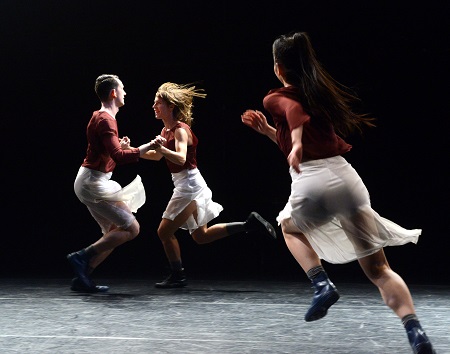Toronto Dance Theatre presents a Triple Bill of work as part of Harbourfront Centre’s NextSteps
The Triple Bill show at the Harbourfront Centre right now isn’t pretending. Featuring a new and an old work by Toronto Dance Theatre artistic director Christopher House, and an unsettling piece by Swiss choreographer Thomas Hauert, the program doesn’t offer any happy fictions. And it’s precisely that connection to the real world that makes this show so interesting and so worthwhile.
Martingales, House’s new collaboration with Toronto-based electronic musician Thom Gill and the first piece on the program, isn’t quite a choreography, at least not in the way we tend to think of a choreography. The dancers haven’t memorized a sequence of carefully timed movements, or organized a set of interesting gestures into a story. Nothing like that. Rather, they’ve learned the rules to a game, and they do the next logical thing: they play.
Actually, the title of the work, Martingales, refers to a type of “game” in probability theory, in which the player never gains from experience. The mathematics behind this concept is beyond me, but one really obvious example of a martingale is gambling. Assuming the game isn’t rigged, then the outcome of one bet doesn’t influence the next. Taken together, all the wins and losses a gambler experiences represent a martingale.
In other words, it’s an image of randomness. But it’s not completely random, because there are rules: the rules of the game, and the rules of the dance. In this piece, the rules put the dancers in constant motion—running, leaping, and spinning around the stage. As they encounter each other, they connect in fleeting configurations and then separate again.
House and Gill are exploring the aesthetics of surprise. They and the dancers aren’t trying to manipulate an outcome; instead, they want to see what kind of beauty or interest will emerge spontaneously from different conditions.
It’s a risky approach. Leaving things to chance is just that—chancy. What if the fates fail to conspire?
I don’t know if the collaborators discovered what they were hoping for, but I found Martingales an exhilarating work. The dancers move really quickly at times, in bursts of speed or running backwards, and with twelve of them on stage, it all feels rather dangerous and exciting. The dancers themselves clearly feel it too, often smiling uncontrollably as they sail around like particles in space, head-long and irrepressible.
Although an absorbing offering, at this point Martingales is still a work in progress, in development for a full-length performance in 2016. I was thoroughly swept away by the combination of House’s elemental movements, Bojana Stancic‘s elegantly airy costumes, and Gill’s unobtrusive atmospheric innovations, but ultimately the piece still felt like a set of experiments rather than a completed work.
The next piece on the program is a relatively early work by House, aptly titled Early Departures, which was first performed in 1992, two years before he became Artistic Director of Toronto Dance Theatre. Performed by four male dancers in dressed-down Bay Street attire, Early Departures presents a decidedly masculine version of bureaucratic frustration and the complexities of office culture.
The strongest emotion in Early Departures comes from the music. Cascading dissonant sounds create a sensation of being trapped in a broken system. Gratingly uncomfortable, the score feels like a distinctly nineties version of the avant-garde: unfriendly, disorienting, and severe. It’ll make you sit up straight and pay attention.
At first I felt overwhelmed by this uneasy mood, but once I adjusted to the sense of distortion, I was surprised to find a playfulness in the work, and the surreal jazz soundscape suddenly started to feel kind of fun. There’s an inevitable clownishness to the formality of office life that House slyly highlights.
Early Departures also reminded me strongly of the sculptural aspect of dance. The four dancers meld together into a single animated form, continually folding in on itself and generating new shapes.
The final work of the evening is Pond Skaters by Hauert. Using stark, minimalist lighting, Hauert creates a caged environment, through which five dancers move about with animal detachment, wearing brilliant floral costumes. It’s ominous and beautiful, like a factory farm for exotic birds.
The extremely diverse music in Pond Skaters comes on intermittently, over top of a field recording from a barnyard or aviary of some sort. Because the physical setting is so bare and deprived, as at a bad zoo, the liveliness of the scattered musical interruptions feels strangely tragic. There’s an overwhelming sense that the world is neither good nor safe, and yet it is full of wonderfully good things. The beauty is there, but it’s not okay.
Details
- Triple Bill is playing at the Fleck Dance Theatre in the Harbourfront Centre (235 Queens Quay West).
- Shows run November 4-8 at 8pm.
- Tickets are $20-$40, with special pricing for students, seniors, and CADA members.
- Tickets can be purchased at the box office or online.
Photo: Members of the Toronto Dance Theatre company in Triple Bill. Photo by Guntar Kravis.

